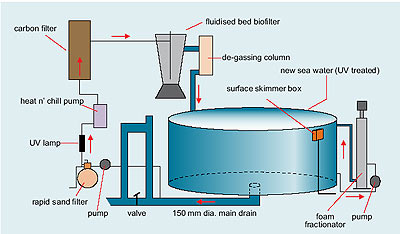Mariculture in the Northern Territory
Barramundi - Breeding
The following information is taken from: NorthernTerritory Barramundi Farming Handbook Department of Primary Industry, Fisheries and Mines By Glenn Schipp, Jérôme Bosmans and John Humphrey
Hatchery production starts with the spawning of captive breeding fish known as ‘broodstock’ and is completed when the small fish or ‘fingerlings’ are 20–25 mm long and are feeding on formulated diets. In the Northern Territory, the Darwin Aquaculture Centre (DAC) is still the sole source of larvae and fingerlings, although this is expected to change in the near future. Barramundi broodstock at the Darwin Aquaculture Centre are maintained in several, large, fibreglass, seawater tanks. The main breeding fish are kept in a 70,000 L fibreglass tank (right) operated on a re-circulating sea water system (see diagram below). |
. |
Up to ten female and twenty male fish are kept in the tank with a maximum weight of 450 kg. Some of the fish maintained n the re-circulating system have been kept in breeding condition all year round.
A ‘heat ‘n chill’ pump is part of the re-circulation system and controls the tank’s water temperature which is normally kept at 30°C (the same as the temperature at he height of the natural spawning season). The salinity is kept at 30 ppt and day length is set at 13 hours using artificial lighting. The salinity in the tank is periodically changed to fresh water for disease control. Once or twice a year over a period of 8–10 weeks the broodstock tanks are changed to cooler water temperatures (23–24°C) and shorter day lengths, to simulate dry season conditions. This helps keep the fish in best breeding condition.
Broodstock barramundi are fed, three days a week, with a high quality diet of freshly thawed whole mullet and squid. Their feed also contains a special diet additive and vitamins. |
| |
|

|
Main features of the 70,000 L re-circulating,
barramundi broodstock tank.
Water is drawn from the main drain, filtered through a sand filter and then passed by an Ultra-Violet lamp to kill bacteria, etc. From there it is heated or cooled through a reverse cycle heat exchanger and then on through a carbon filter to reduce the organic content. Fish wasteslike ammonia are removed using a fluidised bed biofilter and the water gravity feeds back to the tank through a de-gassing column. More organic material in the water is removed using a separate foam fractionation unit. New, UV treated sea water is added at the rate of 10 L per minute. The arrows show the direction of the water movement |
Next: Barramundi Aquaculture |
|